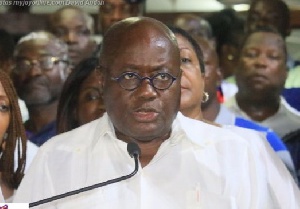- Home - News
- TWI News | TV
- Polls
- Year In Review
- News Archive
- Crime & Punishment
- Politics
- Regional
- Editorial
- Health
- Ghanaians Abroad
- Tabloid
- Africa
- Religion
- Election 2020
- Coronavirus
- News Videos | TV
- Photo Archives
- News Headlines
- Press Release
Opinions of Monday, 23 January 2017
Columnist: Badu, K
Why President Akufo-Addo’s appointees must resort to moral valence
By K. Badu
In 2016, Ghanaians reacted to the apparent harsh economic conditions by clamouring and opting for a change. A change I am blissfully preferred to call macro and episodic.
Macro and episodic change, according to Weick and Quinn (1999), is: “infrequent, discontinuous and intentional.”
In practice, macro and episodic change is often viewed as ‘radical’ or ‘second order’ change; episodic change generally involves replacement of one strategy or programme with another (Weick and Quinn 1999).
Change, by definition, requires creating a new system, which in turn, requires effective team and leadership (Kotter 1990).
Gill (2003), however, postulates that if change is a process of leading an organisation or a nation on a journey from its current state to a desired future state, and thereby handling all the problems that arise along the journey, then change concerns leadership as well as management.
Interestingly, however, John Dewey (1920), observed: “Since changes are going on anyway, the great thing is to learn enough about them; “conditions and events are neither to be fled from nor passively acquiesced in; they are to be utilised and directed”
Obviously, President Akufo-Addo is busily assembling his team with a view to working collaboratively to achieving the desired objectives. Yet a section of Ghanaians are hastily fretting thy souls with dubieties and posing: are the appointees going to give us the optimal performance?
Actually, a team is a group of individuals who are collectively accountable and responsible for specific outcomes, whose members have a high degree of interdependence and interaction (Baldwin, Bommer, and Rubin 2008).
The fact is, teams are supposed to work collaboratively towards achieving a high level of performance, possess complementary skills, trust in one another, commit to a common purpose, and have goals (both explicit and implicit) for which members are held mutually accountable (Katzenbach and Smith 1993).
In a great scheme of things, groups need to develop into effective teams in order to be able to coordinate individual activities for pragmatic outcomes (Hoegl and Gemuenden, (2001).
Thus, Hoegl (2005) posits that the quality of teamwork can comprehensively be assessed by considering six thematic factors of the collaborative work process: communication, coordination, and balance of member contributions, mutual support, effort, and cohesion.
In a way, the six teamwork quality facets espouse elements of both task-related and social interaction within teams (Cummings, 1978; Hoegl et al., 2003).
Learning to work collaboratively and share new knowledge across professional boundaries can be a complicated and challenging process (Wenger, 1998; Gilley and Kerno, 2010).
Moreover, while group or team working can be a challenge, there is an established recognition of the importance of frameworks, interpretive models, systems and flexible methodologies in enabling groups, or specific teams, to identify common values and learn to handle challenges and work collaboratively and systematically to achieve a common goal (Checkland & Poulter, 2006).
In essence, the team members have to identify themselves with the team (Bushe and Coetzer (2007).
Some experts however posit four pillars of an effective collaborative team as: degree of integration, team membership, team process issues, and team management (Øvretveit 1997).
While Baker, Day, & Salas, (2006) observe that service delivery is a joint effort by team members, whose tasks, interaction and collaboration need to be synchronised.
In the same vein, team collaboration has been earmarked as a shared aims, interdependence, and a collegial and equal relationship between the participants and shared decision-making efforts (D’Amour, Ferrada-Videla, San Martín-Rodriquez, & Beaulieu, 2005).
Interestingly, however, Housley, (2003) notes that the development of effective teams involves examining work and the object of work as a whole, integrating competence and expertise from various areas in the team.
The expectation, however, is that team collaboration would enhance quality of service delivery (Baker et al., 2006).
In practice, the aim of team collaboration is to fortify the effectiveness of service delivery by strengthening integrated working across board (D’Amour et al., 2005).
Nevertheless, Moore (2007) postulates that despite its importance, collaborative working has been identified as extremely complex due to many diversities and disparities in professional practice such as values and professional inequalities.
There is also a contending school of thought that argues that collaborative working is often marked by fragmentation, competing priorities, arbitrary divisions of responsibility, inconsistent policy, unpooled resources and unshared boundaries (Hannigan, 1999).
On the other hand, the absence of coordination, unpooled resources and lack of operational integration produce wasteful and inefficient services (Hannigan, 1999).
In a grand scheme of things, team working has a perceptible likeness to “harnessing a crab, a swan, and a pike onto a single wagon and expecting them to move” (Tubin and Levin-Rozalis, 2008).
As a matter of fact, the aforementioned creatures have dissimilar adaptations, and there is no propinquity between them. In other words, they differ in nature and more so culturally incongruous.
So, in order to get them “moving” together effectively, they must first learn how to do that, in other words, they must undergo group process to unlock the innate barriers (Bushe and Coetzer, (2007).
To put it metaphorically, tying “a swan, a crab and a pike” and tasking them to “move” together smoothly without tackling the inherent barriers would be an uphill task by all means. For it is apparent that they would not be able to communicate with one another initially.
For example, “a swan may speak swanese language”; a crab speaks “crabi” language and a pike probably speaks “pikian” language.
Again, they are different creatures and therefore have different ways of doing things.
Patently, there are inequalities between them, although the three creatures all have some kind of sea life knowledge, But then again, they have differing adaptations. For instance, a swan can fly, a crab can only probably swim and crawl, on the other hand, a pike cannot fly but may swim adequately. In essence, they may not understand each other, hence the need to assimilate or to undergo group process.
In a way, the preceding scenario explains the inequalities and the seeming challenges that confront professional groups that seek to work collaboratively (Millward and Jeffries, 2001).
As a matter of fact, a team is a very special form of group. Members cooperate and voluntarily coordinate their work. Within the team there should be a high level of cohesion, participation, support and shared values. And in order to reach this stage of maturity, teams need to develop and grow.
Let us face it, though, the dynamics of a team are highly complex, hence getting President Akufo Addo’s team to work effectively may take time.
By and large, despite the seeming umpteen challenges associated with team working, some optimists however contend that in the presence of periodic on-job training, effective interactions, information sharing, mutual respect and understanding, the team can work synergistically towards achieving a common goal (Reeves et al. 2009).
NB: References are available on request.











